Haru Military Equipment: Difference between revisions
| Line 677: | Line 677: | ||
|} | |} | ||
===Helicopter=== | ===Non-Combat Helicopter=== | ||
{| class="wikitable" | {| class="wikitable" | ||
! Image | ! Image | ||
Revision as of 00:20, 2 May 2023
[[Main Page]]
Submachine guns
| MSG-01 | 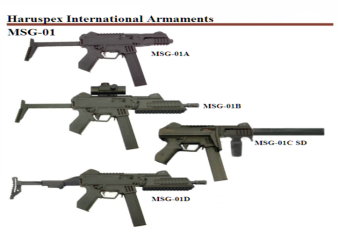
|
Submachine gun | 10mm +P+ class 7N31 AP | 30- or 50-round magazines. The MSG-01 models are in use with the HIL in a variety of roles. Generally special forces, and armored vehicle crews. |
Rifles & Etc
| HBAS Series| The HBAS Bullpup Assault System | 
|
Bullpup Assault rifle | 6.8mm +P+ class 7N31 AP | Made of a rugged, high impact polymer, most of the manufacturing is done utilising CNC machines, with ultrasonic welding for the steel-reinforced receiver halves and the gun barrel being cold hammer forged. It's operating system, boasts a higher reliability over the CBAR's and a lower recoil. The translucent 30 round magazine allows precise assessment of current ammo load to it's operator. The HBAS makes use of 6.8mm +P+ class 7N31 AP (Is compatible with 6.8 SPC rounds) The main draw point is that the HBAS and variants provides carbine length, but rifle muzzle velocity. The bullpup design is also used to minimize the silhouette of soldiers and to maximize effectiveness in turning corners in urban warfare. |
| GAR-01B | 
|
Bullpup Assault rifle | 6.8mm +P+ class 7N31 AP | The GAR-01TB (Gazelle Automatic Rifle) was developed in Runic by the Tenaldunyda uv Semedyno Ehticdno (Directorate of Military Industry - TSE), and was first displayed to public in 2006. Highly reliable, the weapon has been built to withstand severe conditions and be easy to maintain. It's ambidextrous design makes it easy to reload and operate as well. Magazines are equipped with winding handle, so they can be stored loaded and with unwound spring, to avoid loss of spring tension during the storage time. When required, magazine spring can be quickly wound up by rotating the handle to prepare magazine for firing. Magazines hold 125 rounds in a relatively compact package. |
| ACS-01 | 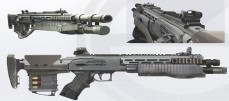
|
Shotgun | 19.5x76mm | In the early 1980s a program called BUAWS (Bullpup Urban Assault Weapon System), was begun under a joint venture with Verlaine Corporate Industries and that of Haruspex International Armaments. The main goal of this programme was to develop a new generation personal firearm, capable of firing high-impulse, multiple projectiles with effective range of 100-150 meters. Using of the multiple projectiles should increase the chances of hitting the target in combat.
The ACS-01 is a bullpup select-fire, smooth-bore weapon, designed to fire special, high-pressure shotshells, loaded with tungsten buckshot or flechettes. CUAWS researchers developed and utilised a patented recoil-operated action with moving barrel and additional, self-regulated gas assist system (used to help unlock breechblock from the barrel if low-power ammo is used). The main goal of this system was to decrease felt recoil down to suitable level. The ACS-01 shotguns are gas-operated, semi-automatic weapons that use long-stroke gas piston located above the barrel. Gas system is fitted with two-position manual gas regulator, to provide reliable functioning with standard magnum (76mm) ammunition. Barrel is locked by rotary bolt. Barrel bore and action are chromed to provide better corrosion resistance. Barrels can be fitted with optional interchangeable chokes. Feed is from detachable drum magazines, holding 30 rounds or stick mags of 10 rounds. Standard furniture includes a long front and either a butt with integral semi-pistol grip or separate pistol grip and side-folding polymer butt. Standard sighting equipment includes a rifle-type rear sight at the front of receiver and a front sight above the gas block. Some version can be fitted with side rail on receiver which can accept mounts for red-dot or other sights. |
| CCNML-01 | 
|
Anti-Personnel rifle | 12.7x54mm special subsonic | The 12.7mm CCNML-01 (Cbaleym Cheban Nevma, mynka lymepan - special sniper rifle, large caliber) supressor sniper rifle is one of the most recent creations of Verlaine Corporate Industries Instrument Design Bureau (ETP). Developed in around 2002 on special request from the Esbaneis Calinedo Canjelac (ECC - "Imperium Security Services"), this rifle was first shown to general public only in late 2005, during arms exhibition FAS 2005 in Prathen. This rifle is said to be in use only by special elements of the ECC and the military legions, which conduct anti-terror and high importance anti-crime operation. Accuracy is claimed as 1 MOA at 100 meters range with precision bullets, and maximum effective range is given at 600 meters. High penetration bullet can defeat Imperium Class 5 (US NIJ Type III / High-Powered Rifle) body armor at 100 meters or 16mm steel plate at 200 meters. The SA-01 cases are based on the .338 Lapua Magnum cases with straight (no neck), and a slightly tapered body. |
Machineguns
| GLM Series| The General Light Machinegun Series | 
|
LMG | 6.8x54mm Haruspex Imperium | The GLMshares in the same polymer construction and general appearance of many HIA weaponry styles. The weapon's receiver is made from stamped sheet steel, reinforced with welded and riveted machined steel inserts. Synthetics were also used (i.e. the handguards, pistol grip, buttpad and cheek rest were all fabricated from nylon). A railed handguard was also developed for the type. GLM prototypes were tested in 1996 and production was completed in 2004.
The GLM utilizes a system that is of a selective fire gas-operated design. The weapon uses ignited powder gases bled through a port in the barrel to provide the weapon's automation. The LMG uses a short-stroke gas piston system located above the barrel, which is fed gas through a three-position adjustable gas regulator. The first gas setting is used for normal operation, the second, for use in difficult environmental conditions and the third setting prevents any gas from reaching the piston, and is used to launch rifle grenades. The weapon uses a rotating cylindrical bolt that contains 7 radially-mounted locking lugs, an extractor and casing ejector. The bolt's rotation is controlled by a cam pin that slides inside a helical camming guide machined into the bolt carrier. The family is built in a traditional layout (the magazine is in front of the trigger), with a rear-mounted pistol grip. The main advantage of this type of arrangement is the overall compactness of the weapon, which can be achieved without compromising the barrel length, hence the overall length of the GLM-01 LMG is shorter than a carbine, but the barrel length is that of an assault rifle. The GLM-01 is hammer-fired and has a trigger mechanism with a fire-control selector that enables semi-automatic fire and fully automatic fire (the fire selector lever is located at the left side of the receiver, just aft of the helical magazine). A cross bolt type safety prevents accidental firing and is located above the trigger; the "safe" setting blocks the movement of the trigger. The weapons are fed from a helical drum magazine, usually with a 225-round capacity, although a large ammo bag may be attached with a 500-round capacity. The magazine release button is placed above the magazine housing, on the left side of the receiver. When the last cartridge is fired from the magazine the bolt and bolt carrier assembly lock to the rear. The GLM-01 LMG also features a barrel with a slotted flash suppressor. |
Infantry Support
| ASRHS-2| The Airborne Short Rifled Howitzer Series 2 | 
|
Artillery | 75 mm | This weapon is a short-rifled howitzer without a recoil or counter-recoil system, mounted on a light aluminum alloy carriage. A funneled (Venturi) tube is attached to the rear of the bored breechblock; its function is to allow the gases to disperse to the rear, thus eliminating a recoil mechanism.
The firing mechanism is seated in a cone-shaped receptacle and centered in the breechblock by vertical struts. The weight of the complete gun is reduced to a minimum by using hollow machined parts, plastic washers, tubular carriage, and aluminum alloy body. Because of the weight of the complete piece, it lends itself to use by airborne troops. |
| 9M-Zylgym (Jackal) MPS| 9M-Zylgym (Jackal) Man Portable System | 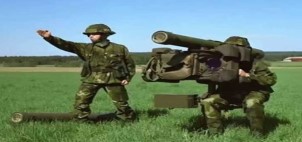
|
Manportable/Vehicle mounted surface-to-air missile | 3 kg HE fragmentation with contact and proximity fuzing | The effectiveness of the 9M1 missile against air targets is attributed to the increase weight of the explosive in the missile's warhead and to the impact/proximity fuze enabling the missile to kill the target both in the event of a direct hit and when it passes at a distance of up to 1.5 m from the target.
The set comprises a universal launcher module for one to four missiles, control and communication equipment, one remote control box, checkout equipment and maintenance kit. The 9M-Zylgym systems can be mounted on ground-based, airborne and sea based platforms. Its full-reloading time is 4 min, loaded launch unit weight - 70 kg, control equipment weight - 24 kg. The launch unit of this system is mounted on tracked or wheeled-type chassis and can be employed in a portable version utilizing a tri-pod setup. |
| Anti-Personnel Mine| The SM-01A " Cbetan " (Spider) Mine | 
|
Mine | Warheads vary, but are generally 1kg | The Cbetan Smart Mine (Spider) is more of a “remote explosive device” than a typical lay-and-forget land mine. It’s detonated by soldier command, and that soldier can even load non-lethal canisters if the mission calls for it. Unlike conventional land mines, the CM-01A Cbetan always has a known location, so it can be safely and easily recovered and redeployed. If that isn't possible for some reason, CM-01A units deactivate after a set time period, so they won’t become a future threat. It's capabilities are badly needed in places like remote fire bases, and or border defensive areas.
A CM-01A Cbetan system consists of up to 63 Munition Control Units (MCUs). They are set up by humans, unlike some land mines that are fired into place using artillery, mortars, or rockets. Each MCU can contain up to 6 reloadable canisters spaced around the device, each of which covers a 60 degree arc to create full 360 degree coverage. Payloads can be anything from Claymore-style steel balls or fragments, to non-lethal gasses or goo. |
Military Utility Vehicles
| Image | Manufacturer | Designation | Variants | Type | Quantity | Country of Origin | Operators | Notes | |
|---|---|---|---|---|---|---|---|---|---|
| HIA | FS-42 | Panzer/Armoured Vehicle Hauler | 234 Vehicles | HIL Logistics Vehicle. | |||||

|
HIA | H17 3.5-Ton Cargo Truck | 5
|
Military Logistics Vehicle | 16,000 Vehicles | HIL Primary service vehicle. | |||

|
HIA | Vannad (Ferret) MUV | Military Utility Vehicle | 14,000 Vehicles | HIL Primary service vehicle. | ||||

|
HIA | Rihdan (Hunter) LMV | Light Multirole Vehicle | 12,000 Vehicles | KMLF/NKPDF current service vehicle. HIL Homeguard-Reserve use. | ||||
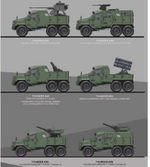
|
HIA | Drihtan (Thunder) ISV | 6
|
Infantry Support Vehicle | 6,000 Vehicles | HIL support vehicle replacing the Valkyrie MARS. |
Armored Personnel Carrier
| Image | Manufacturer | Designation | Variants | Type | Quantity | Country of Origin | Operators | Notes | |
|---|---|---|---|---|---|---|---|---|---|

|
HIA | S-12 Half Track Series | 24
|
Armored Personnel Carrier | 6,525 Vehicles | Mainstay HIL, and colonial APC in service |
Infantry Fighting Vehicle
| Image | Manufacturer | Designation | Variants | Type | Quantity | Country of Origin | Operators | Notes | |
|---|---|---|---|---|---|---|---|---|---|

|
HIA | S-11 IFV | 16
|
Infantry Fighting Vehicle | 3,450 Vehicles | Panzer escort. | |||

|
HIA | LAV-25 Jeban (Viper) | Infantry Fighting Vehicle | 7,725 Vehicles | Panzer escort, mainstay IFV. |
Tanks
| Image | Manufacturer | Designation | Variants | Type | Quantity | Country of Origin | Operators | Notes |
|---|---|---|---|---|---|---|---|---|

|
HIA | S-98 Myht Fumv (Land Wolf) MBT | Main Battle Tank | 2,200 Vehicles | ||||

|
HIA | Rubmeda (Hoplite) LST | Reconnaissance tank | 1,551 Vehicles |
Anti-Personnel/Tank
| Image | Manufacturer | Designation | Variants | Type | Quantity | Country of Origin | Operators | Notes | |
|---|---|---|---|---|---|---|---|---|---|
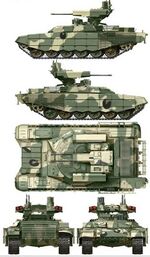
|
HIA | S-17 | Anti-Personnel/Tank Vehicle | 2,750 Vehicles | Panzer escort and anti-personnel vehicle. |
Anti-Tank
| Image | Manufacturer | Designation | Variants | Type | Quantity | Country of Origin | Operators | Notes | |
|---|---|---|---|---|---|---|---|---|---|

|
HIA | Q39 Nota'man (Devil) | 2
|
Anti-Vehicle/Tank | 2,250 Vehicles | Anti-Tank is the primary role. There is 1 other variant. |
Artillery Systems
| Image | Manufacturer | Designation | Variants | Type | Quantity | Country of Origin | Operators | Notes | |
|---|---|---|---|---|---|---|---|---|---|

|
HIA | Tajem (Devil) H-MARS | Multiple Launch Rocket System | 1,522 Vehicles | https://www.artstation.com/nomansnodead | ||||

|
HIA | Ryssan (Hammer) | Self Propelled Artillery System | 572 Vehicles | Mainstay HIL long range SPG. | ||||

|
HIA | TAC-12 Towed 155mm Howitzer | Artillery | 14,212 Guns | Mainstay HIL towed artillery. |
Mobile Anti-Aircraft
| Image | Manufacturer | Designation | Variants | Type | Quantity | Country of Origin | Operators | Notes | |
|---|---|---|---|---|---|---|---|---|---|

|
HIA | Pylg Cdyp (Back Stab) | Mobile Anti-Aerocraft | 2,534 Vehicles | Most widespread mobile AA vehicle within the HIL and colonies. | ||||
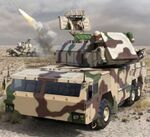
|
HIA | Chyyban (Snapper) MRMLS | Multi-Role Missile Launcher System | 1,552 Vehicles | Successor to the Pylg Cdyp (Back Stab). |
Drones
| Image | Manufacturer | Designation | Variants | Type | Quantity | Country of Origin | Operators | Notes | |
|---|---|---|---|---|---|---|---|---|---|

|
HIA | HK-03 Hehzy (Ninja) |
|
Unmanned Armed Aero System | 1,160 Aerocraft | UAAS used HIL, HIN, and HAD. |
Interceptor
| Image | Manufacturer | Designation | Variants | Type | Quantity | Country of Origin | Operators | Notes |
|---|---|---|---|---|---|---|---|---|

|
HAD | 22b Lupny (Cobra) |
|
Interceptor Aerocraft | 235 Aerocraft | KMLF/NKPDF mainstay aerocraft and trainer. Homeguard-Reservist HAD. |
Ground Attack
| Image | Manufacturer | Designation | Variants | Type | Quantity | Country of Origin | Operators | Notes | |
|---|---|---|---|---|---|---|---|---|---|

|
HIA | S30 Sylrada (Machete) | Ground Support Aerocraft | 302 Aerocraft | HIL, and HIN primary for air-to-ground missions. |
Multi-Role Aerocraft
| Image | Manufacturer | Designation | Variants | Type | Quantity | Country of Origin | Operators | Notes | |
|---|---|---|---|---|---|---|---|---|---|
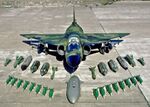
|
HAD | S37 Nyddman (Rattler) | Multi-Role Aerocraft | 348 Aerocraft | KLMF and HIL Frontline support combat aerocraft. | ||||
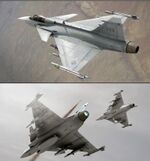
|
HAD-HIA | S39 Jeban (Viper) | Multi-Role Aerocraft | 643 Aerocraft | KLMF/NKPDF and HIL primary frontline combat aerocraft. |
Strategic Aerocraft
| Image | Manufacturer | Designation | Variants | Type | Quantity | Country of Origin | Operators | Notes | |
|---|---|---|---|---|---|---|---|---|---|

|
HAD | S-20 Fryma (Whale) SLRA |
|
Strategic Long-Range Aerocraft | 122 Aerocraft | KLMF/NKPDF and HIL primary strategic platform aerocraft. |
Non-Combat Aerocraft
| Image | Manufacturer | Designation | Variants | Type | Quantity | Country of Origin | Operators | Notes | |
|---|---|---|---|---|---|---|---|---|---|

|
HAD | HT-01 Vycd Muytan (Fast Mover) | Cargo Aerocraft | 250 Aerocraft | Primary non-combat logistics aerocraft. |
Non-Combat Helicopter
| Image | Manufacturer | Designation | Variants | Type | Quantity | Country of Origin | Operators | Notes | |
|---|---|---|---|---|---|---|---|---|---|

|
HAD | V-33H CibanVnuk (SuperFrog) | Heavy Lift Helicopter | 146 Aerocraft | Used almost exclusively by the KMLF, limited use by regular HIL. |
Attack Helicopters/Gunships
| Ryfg| The Ryfg (Hawk) Attack Helicopter/Gunship | 
|
Attack Helicopter/Gunship
|
378 Aerocraft | The Ryfg(Hawk) AH-01 has a Rotorprop tail rotor which could rotate its axis through 90° to act both as a conventional anti-torque rotor in horizontal flight and as a pusher propeller, thereby transforming the Ryfg AH-01 into a compound aircraft in cruising flight.
Ryfg AH-01 can be armed with a wide variety of unguided rockets ranging from 20 mm to 130 mm caliber. The largest rockets tested were a type of 130 mm rocket that were carried on the hardpoints just as missiles are carried, while smaller caliber rockets were mounted in conventional rocket pods. The most frequently used rockets are those ranging from 57 mm to 90 mm and a total of 4 pods can be carried under the stub wings, one under each hardpoint. |
VTOL
| TE-01B| TE-01B Dymuh (Talon) VTOL Gunship | 
|
VTOL Gunship | 399 Aerocraft | The Dymuh (Talon), Pronounced: "DEaemoo-ha", is a vertical takeoff and landing aerocraft that supports a tilt-engine design in similarity to that of the tilt-rotor concepts. Primary role is to act in the role formerly filled by previous generation attack helicopters.
The main weapon of the attack VTOL is a 20 mm autocannon in a nose mounted turret. The turret is designed for sixty degree side to side rotation and forty-five degree up and down movement. On the hard points near the cockpit are permanent large capacity mini-missile pods. The aircraft carries four additional wing hard points on the outer wings outside of the lift engines. These hardpoints can carry bombs, missiles, additional mini-missile pods such as 'Hellfires', or even additional guns. Unlike the nose mounted gun, these guns are fixed forward. For additional protection, the Dymuh is equipped with chaff and flare dispensers. The weaponry on the attack aircraft make it ideally suited to attack troops, protective bunkers, and armored vehicles. To a lesser extent, it is capable of engaging air targets as well. |
| TR-02| The TR-02 Aykma (Eagle) VTOL | 
|
VTOL ASW | 120 Aerocraft | The TR-02 Aykma (Eagle) is a tilt rotor design. The aircraft flies much like a conventional aircraft in most cases but the blades can be flipped upwards so that the aircraft can hover. The aircraft is much faster than helicopters in level flight but can hover just like a helicopter. The TR-02's main function is ASW, however it can suit many roles including transport, gunship, and electronics warfare.
The anti-submarine warfare version carries a dipping sonar and magnetic anomaly detector (known as MAD gear) for submarine hunting. In addition, the aircraft can carry a large number of sonar buoys. A total of thirty-two sonar buoys can be carried in the cargo hold. The anti-submarine warfare version of the TR-02 'Aykma' has a crew of four with two of the crew acting as sensor operators. Usually, torpedoes would be carried on anti-submarine versions of the aircraft when operating in the anti-submarine role. Both the transport and anti-submarine warfare versions of the TR-02 'Aykma' have a cargo hook. |
| 202 FPAC| The 202 Cemjanvecr (Silverfish) FPAC | 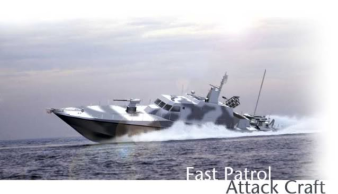
|
FPAC | 52 | The Cemjanvecr FPAC has been developed for a tough professional use with excellent performance qualities at both low and high speeds and strong emphasis on seakeeping. The deep V hull, will enable the boat to reach speeds up to 64 knots in calm waters and up to 40 knots in Sea State 4. Soft and dry ride in adverse conditions, offering, thus, an outstanding platform for the various tasks in the brown waters and the open sea. |
| 205 Class| The 205 Ymekydun (Alligator) Class Corvette | 
|
Corvette | 48 | The design has been directed to minimizing the optical and infrared signature, above water acoustic and hydro acoustic signature, underwater electrical potential and magnetic signature, pressure signature, radar cross section and actively emitted signals. The hull material is a sandwich construction comprising a PVC core with a carbon fiber and vinyl laminate. The material provides high strength and rigidity, low weight, good shock resistance, low radar and magnetic signature. |
| Cay Kut Class| The Cay Kut (Sea God) Class OHAAS | 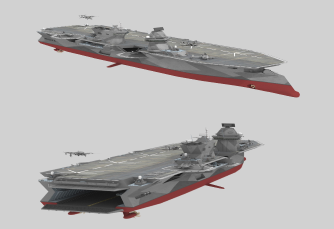
|
OHAAS | 10 | The requirements for the new assault carrier Cay Kut (Sea God) class design included many improvements which included the ability of the carrier to act virtually in the role of a normal carrier. The vessel could act as a Sea control vessel and in that mission, the number of carried ground assault aircraft is reduced so the ship can carry more fighters. Other features included much better self defense weaponry and a hull and superstructure design to give the vessel some stealth. |
| Dymuh Class| The Dymuh (Talon) Amphibious Assault Ship | 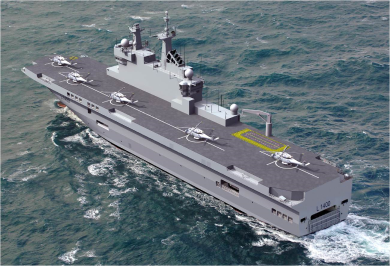
|
OHAAS | 10 | As a high-speed amphibious ship, the Dymuh is based on the concept of "over-the-horizon assault." As the name indicates, the "over-the-horizon assault" comprises a military operation in which an amphibious landing operation is conducted with high-speed air-cushioned vehicles and helicopters from beyond the horizon, where they can't be easily detected or attacked by the enemy. The conventional LST (landing ship tank) has to approach the coastline for landing, at the risk of being fired upon by the enemy. |
| 210 Class| The 210 Dekan (Tiger) Class Destroyer | 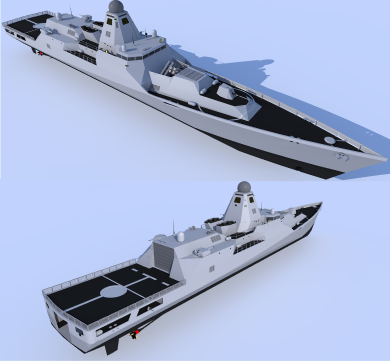
|
Destroyer | 20 | The ships incorporate many items of sensor, weapon, fire-control and propulsion equipment of a variety of Haruspex armaments corporations. HAD input is evident in the short-range SAMs, anti-ship missiles, anti-submarine torpedo system and air-search radar, while HIA input is seen in weapons such as the 127-mm gun, CIWS, with VCI following up in the development of sensors such as the surface-search and fire-control radars, and the sonar.
The Dekan class vessel is designed to incorporate stealth shaping techniques to reduce radar cross-section. Originally tasked with defending against Cussian aircraft, missiles and submarines, this potent vessel is now used in high-threat areas to conduct anti-air, anti-submarine, anti-surface, and strike operations. |
| 212 Class| The 212 Cfunt (Sword) Class Missile Series | 
|
Guided Missile Frigate | 20 | The Cfunt (Sword) Class is a class of frigate designed to engage hostile ships by means of missile attack, and to provide warships and transport ships with protection against ship and air attack. Intended primarily for anti-ship operations, it was designed to compliment anti-submarine warfare (ASW) Olath Vlos destroyers.
Envisaged as a minimum cost, advanced area-defence platform for construction in large numbers, the Cfunt (Sword) Class class has evolved over the years. The design was based on the hull of the cruiser-sized Gigin class destroyer. The Cfunt was originally designated as a destroyer, but the design was redesigned as a frigate in 1990. |
| 214 Class| The 214 Olath Vlos (Dark Blood) Class Destroyer | 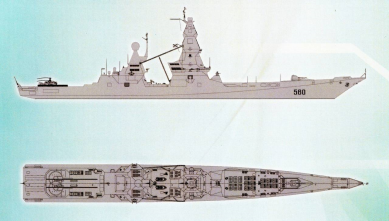
|
Guided Missile Destroyer | 12 | The Olath Vlos (Dark Blood) Class is a long-range escort destroyer class vessel that undertakes roles including area air defense, anti-submarine warfare, surveillance, reconnaissance and interdiction. The ship is capable of countering simultaneous threats from the air, surface and sub-surface. Armed with anti-ship and anti-aircraft missiles plus anti-submarine torpedoes. They also carry a pair of torpedo-armed ASW VTOL aerocraft. |
| N3 RTSV| The standard imperial navy rocketry tracking surface vessel. | 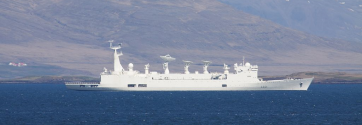
|
Intelligence | 02 | The systems aboard the N3 RTSV Class allow it to track missiles and satellites. There are two navigational radars operating on the I-band, one for control of the helicopters, and a HAD-ASR/B/2 air surveillance radar operating on the E and F-bands. The intelligence systems are a radar operating on the L-band for trajectory tracking, radars for missile tracking operating on the C-band. Furthermore, there are six telemetry-tracking radars operating on the E and F-bands, a laser-radar, and an optical tracking unit, and 14 antennas for telemetry. |
| T39 Class| The Type 39 Crehehk Cuh (Shining Son) class submarine | 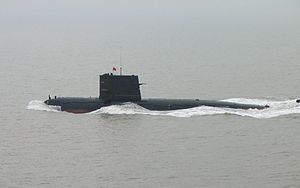
|
Diesel-Electric | 6 | The class is the first diesel-electric Haruspex submarine to use the teardrop hull shape. Primary weapon for the Type 39 is the 533 mm Yu-4 torpedo, a locally produced passive homing 40-knot (74 km/h) torpedo based on the SAET-50 and roughly comparable to the SAET-60. Surface targets may be attacked at up to 15 km. Yu-6 wire-guided torpedoes may also be used for targeting submarines. The Type 39 is capable of carrying the Onyx anti-ship missile, a cruise missile which can be launched from the same tube as the boat's torpedoes, and can target surface vessels at up to 80 km. The missile is subsonic and carries a 165 kg warhead. For mining operations, in place of torpedoes, the submarine can carry 24 to 36 naval mines, deliverable through the torpedo tubes. By general design, the launching system is compatible with AShM, ASW, torpedoes of both Europan and Argic origin. |
| T42 Class| The Type 42 Lydvecr (Catfish) class submarine | 
|
SSK | 5 | The Lydvecr incorporates a double hull system composed of an inner pressure hull and an outer "light" hull. This allows more freedom in the design of the exterior hull shape, resulting in a submarine with more reserve buoyancy than its western analogs. The Lydvecr submarines have reactor coolant scoops similar to the short ones found on the Freda Cryng (White Shark) class submarines.
The distinctive "bulb" or "can" located on top of the rudder, houses its towed sonar array when retracted. Most Lydvecr's have the wake detection system known as (SOKS) of which incorporates hydrodynamic sensors, which detect changes in temperature and salinity. They are located on the leading edge of the sail, on the outer hull casing in front of the sail and on the bottom of the hull forward of the sail. |
| T43 Class| The Type 43 Felgat (Wicked) class submarine | 
|
SSK | 5 | The Type 43 Felgat class is 3 metres (9.8 ft) longer and displaces about 700 tons (submerged displacement) more than its sister class of the Lydvecr. The added space was used for additional quieting measures. Its said to be very quiet and is often times sent on long range surveillance missions into the Adlantic Ocean and other Argic strongholds. |
| T44 Class| The Type 44 Cyht Dekan (Sand Tiger) class submarine | 
|
SSK | 8 | The Type 44 is the first Haru submarine class to be equipped with a spherical sonar, designated as MGK-600. The sonar system consists of a spherical bow array, flank arrays and a towed array. Due to the large size of this spherical array, the torpedo tubes are slanted. In other words, the torpedo tube outer doors are not located in the immediate bow as in the previous Type 43 class but moved aft. The hull is constructed from low-magnetic steel. Unlike previous Haru submarines which have a double hull, Type 44 class submarines mostly have a single hull. |
| T50 Class| The Type 50 Binevean (Purifier) class submarine | 
|
SSGN | 4 | The first submarine was laid down in the mid-1970s and was commissioned in 1980. In 1982 an updated and larger version replaced the earlier version. In total four submarines were constructed. The Binevean class was designed to attack Cussian carrier battle groups using long-range P-700 (SS-N-19 "Shipwreck") anti-ship missiles and targeting data provided by the EORSAT satellite system (via the submarine's "Punch Bowl" antenna). |
| T51 Class| The Type 51 Tyng Sudran (Dark Mother) class submarine | 
|
SSGN | 3 | The external differences between the two classes were that the Type 51 class is about 10 metres (33 ft) longer than its predecessor (approximately 154 metres, 505 ft rather than 143 m, 469 ft), providing space and buoyancy for improved electronics and quieter propulsion. The acoustic performance of the Type 51 class is superior to early Type 42 class but inferior to the Type 44 class. It also has a larger fin, and its propellers have seven blades instead of four.
As part of the modernization, The Type 51 submarines have replaced the P-700 missiles with 72 newer P-800 Onyx anti-ship cruise missiles. The upgrade requires no design changes to the hull as the new missiles will fit into the existing launchers outside the pressure hull. The modernized boats will also get upgraded Omni-M combat information and Niya-3.2 navigation systems, as well as new fire-control system, communications, sonar, radar, and electronic intercept equipment. The modernization aims to bring the submarines up to the same technological level as the Type 44 class. |
| T53 Class| The Type 53 Freda Cryng (White Shark) class submarine | SSBN | 6 | The submarines constitutes a double-hulled configuration with missile silos housed in the inner hull. The forward horizontal hydroplanes are arranged on the sail. They can rotate to the vertical for breaking through the ice cover. The propulsion system provides a speed of 14 knots (26 km/h; 16 mph) surfaced and 24 knots (44 km/h; 28 mph) submerged. The submarines carry supplies for an endurance of 80 days. The surface of the submarines has an acoustic coating to reduce the acoustic signature.
The Type 53 submarines employs the D-9RM launch system and carries 16 R-29RMU liquid-fueled missiles which each carry a singular warhead. Unlike previous modifications, the Type 53 class submarine is able to fire missiles in any direction from a constant course in a circular sector. The underwater firing of the ballistic missiles can be conducted at a depth of 55 meters (180 ft) while cruising at a speed of 6–7 knots (11–13 km/h; 6.9–8.1 mph). All the missiles can be fired in a single salvo. | |
| T55 Class| The Type 55 Dobruuh (Typhoon) class submarine | 
|
SSBN | 2 | Tye 55 class submarines features multiple pressure hulls which simplifies internal design while making the vessel much wider than a normal submarine. In the main body of the sub, two long pressure hulls lie parallel with a third, smaller pressure hull above them (which protrudes just below the sail), and two other pressure hulls for torpedoes and steering gear. This also greatly increases their survivability – even if one pressure hull is breached, the crew members in the other are safe and there is less potential for flooding. Its ballistic missiles are placed between the two main pressure hulls, their launch tubes enclosed only by the outer, "light" hull.
The project was developed with the objective to out match the SLBM armament of hostile submarines, capable of carrying 192 biological and thermobaric conventional warheads. |
| T58 Class| The Type 58 Fetuf (Widow) class submarine | 
|
SSBN | 3 | Despite being a replacement for many types of SSBNs, the Type 58 class submarines are much smaller than those of the Type 55 class in both volume and crew (24,000 tons opposed to 48,000 tons and 107 personnel as opposed to 160 for the Type 55's). In terms of class, they are more accurately a follow-on for the Type 53 SSBNs.
The Type 58 includes improved communication and detection systems, improved acoustic signature and have major structural changes such as addition of all moving rudders and vertical endplates to the hydroplanes for higher maneuverability, and a different sail geometry. They are equipped with hydraulic jets and improved screws that allow them to sail at nearly 30 knots while submerged with minimal noise. |
| Prototypes| The Type 93 and 94 Benyhrhy (Piranhna) class submarines | 
|
Prototypes | 2-1 lost at sea | The Type 93/94 class submarines are nuclear powered ballistic missile submarines built under the Underwater Advanced Technology Vessel (IYDJ) project. The submarines are 111 m (364 ft) long with a beam of 11 m (36 ft), a draught of 15 m (49 ft), displacement of 6,000 tonnes (5,900 long tons; 6,600 short tons). The complement is about 95, including officers and sailors. The boats are powered by a single seven blade rimless propeller arrangement powered by an 83 MW pressurized water reactor and can achieve a maximum speed of 12–15 knots (22–28 km/h) when surfaced and 24 knots (44 km/h) when submerged.
One vessel, HIN 193 has been lost in the Geltic Sea due to unforeseen consequences. |
| N6 MSV| The N6 Caagan (Seeker) class minesweeper and patrol vessel. | 
|
Minelayer & Sweeper | 11 | Its main missions are gathering data of ports in the Cetan Sea/Protectorate of North Korinon territory, and searching naval mine and minesweeping to protect sea lanes and routes. Much like the N5 class, the N6 class is often used as sea-going/coastal patrol vessels. |
| N5 MSV| The N5 Clyjyhkan (Scavanger) class minesweeper and patrol vessel. | 
|
Minelayer & Sweeper | 14 | Its main missions are gathering data of ports in the Amnelos Sea/Greater Kaldana territory, and searching naval mine and minesweeping to protect sea lanes and routes. The N5 class is capable of ocean going patrol missions as well and is often used as such. |
| N1 Support| The standard imperial navy supply and support class. | 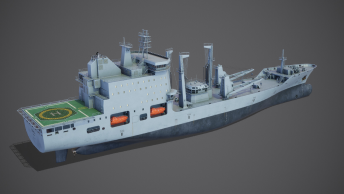
|
Support | 46 | The N1 class has two dual solid/liquid underway transfer stations per side and can replenish two ships per side and one astern. The class was initially designed to have the capacity for 5,170 t (5,090 long tons) of fuel oil, 3,360 t (3,310 long tons) of diesel fuel, 1,160 t (1,140 long tons) of JP-5 aviation fuel, 250 t (250 long tons) of distilled water, 180 t (180 long tons) of provisions, 170 t (170 long tons) of munitions and 15 t (15 long tons) of spare parts. These numbers change with the needs of the fleet.
Credit for ship design: Stas sayhallo |
| N2 Support| The standard imperial navy submarine tender. | 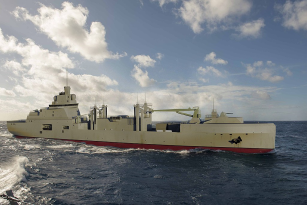
|
Support | 9 | The N2 beyond being a submarine tender can also be utilized as a LyN vessel ("command and replenishment ship"). In addition to their role as a fleet tender, the ships with this added designation can accommodate an entire general staff and thus supervise naval operations as a command ship. The ships of the class designated LyNs, all have superstructures that were extended aft by 8 m (26 ft) to accommodate the additional staff requirements. The LyNs have one crane positioned along the centreline. |
| N4 PSV| The standard imperial navy and corporate platform support vessel. | 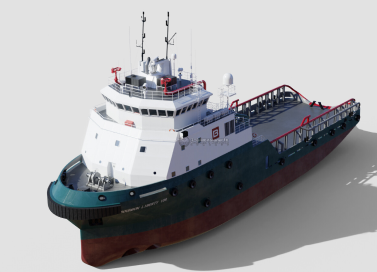
|
Support | 5 | The N4 PSV class is a ship specially designed to supply offshore oil, gas and military platforms. These ships range from 50 to 100 metres (160 to 330 ft) in length and accomplish a variety of tasks. The primary function for most of these vessels is logistic support and transportation of goods, tools, equipment and personnel to and from offshore oil platforms and other offshore structures. In recent years, a new generation of platform supply vessels entered the market, usually equipped with Class 1 or Class 2 dynamic positioning system.
Credit to artwork: 3-dimensional |
